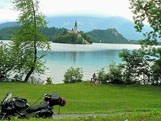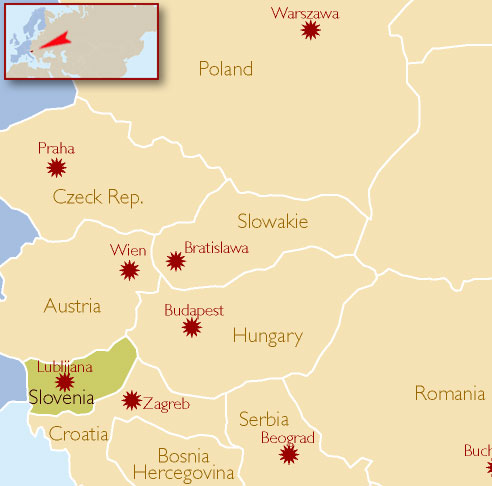Slovenia
The SpecialEasts on the road for you:
Western europe. Eastern europe. Balkans. Turkey. CIS. Middle East. Central Asia.

Zenit offers the following services for Slovenia:
You need to transport goods from or to Slovenia? Just give us a call.
Our team will find the right solution for you!
Slovenia - brief overview about the Zenit destination Slovenia.
Geopraphy

Slovenia is situated in Central Europe touching the Alps and bordering the Mediterranean . The Alps—including the Julian Alps, the Kamnik-Savinja Alps and the Karavanke chain, as well as the Pohorje massif—dominate Northern Slovenia along its long border with Austria. Slovenia's Adriatic coastline stretches approximately 43 km (27 mi) from Italy to Croatia. The term "Karst topography" refers to that of southwestern Slovenia's Kras Plateau, a limestone region of underground rivers, gorges, and caves, between Ljubljana and the Mediterranean. On the Pannonian plain to the East and Northeast, toward the Croatian and Hungarian borders, the landscape is essentially flat. However, the majority of Slovenian terrain is hilly or mountainous, with around 90% of the surface 200 m (656 ft) or more above sea level.
Four major European geographic regions meet in Slovenia: the Alps, the Dinarides, the Pannonian Plain, and the Mediterranean. Slovenia's highest peak is Triglav (2,864 m/9,396 ft); the country's average height above sea level is 557 m (1,827 ft). Although on the shore of the Adriatic Sea, near the Mediterranean, most of Slovenia is in the Black Sea drainage basin. The geographical centre of Slovenia is at the coordinates 46°07'11.8" N and 14°48'55.2" E. It lies in Spodnja Slivna near Va?e in the municipality of Litija. Slovenia's coastline measures 47 km (29 mi).
Around half of the country (11,691 km2/4,514 sq mi) is covered by forests; the third most forested country in Europe, after Finland and Sweden. Remnants of primeval forests are still to be found, the largest in the Ko?evje area. Grassland covers 5,593 km2 (2,159 sq mi) and fields and gardens (954 km2/368 sq mi). There are 363 km2 (140 sq mi) of orchards and 216 km2 (83 sq mi) of vineyards. There is a Continental climate in the northeast, a severe Alpine climate in the high mountain regions, and a sub-Mediterranean climate in the coastal region. Yet there is a strong interaction between these three climatic systems across most of the country. This variety is also reflected in climatic variability over time and is an important factor determining the impact of global climate change in the country.
Demographics

Slovenia's main ethnic group is Slovene (83%). Ethnic groups from other parts of the former Yugoslavia (Serbian, Croatian, Bosnian, Macedonian, Montenegrin) form 5.3%, and the Hungarian, Albanian, Roma, Italian and other minorities form 2.8% of the population. Ethnic affiliation of 8.9% was either undeclared or unknown.
Life expectancy in 2003 was 72.2 years for men and 80 years for women. Slovenia ranks number 4 on the list of countries by suicide rate.
With 99 inhabitants per square kilometre (256/sq mi), Slovenia ranks low among the European countries in population density (compared to 320/km² (829/sq mi) for the Netherlands or 195/km² (505/sq mi) for Italy). The Notranjska-Kras statistical region has the lowest population density while the Central Slovenian statistical region has the highest. Approximately 51% of the population lives in urban areas and 49% in rural areas.
The official language is Slovene, which is a member of the South Slavic language group. Hungarian and Italian enjoy the status of official languages in the ethnically mixed regions along the Hungarian and Italian borders.
By religion, Slovenes are traditionally largely Roman Catholic (57.8% according to the 2002 Census).
According to the most recent Eurobarometer Poll 2005, 37% of Slovenian citizens responded that "they believe there is a god", whereas 46% answered that "they believe there is some sort of spirit or life force" and 16% that "they do not believe there is any sort of spirit, god, or life force".
Economy
Slovenia has a high-income developed economy which enjoys the highest GDP per capita of the new member states in the European Union, at $29,521 in 2008, or 91% of the EU average. Slovenia today is a developed country that enjoys prosperity and stability, as well as a GDP per capita substantially higher than that of the other transitioning economies of Central Europe. It benefits from a well-educated and productive work force, and its political and economic institutions are vigorous and effective.
Although Slovenia has taken a cautious, deliberate approach to economic management and reform, with heavy emphasis on achieving consensus before proceeding, its overall record is one of success. Slovenia's trade is orientated towards other EU countries, mainly Germany, Austria, Italy, and France. This is the result of a wholesale reorientation of trade toward the West and the growing markets of central and eastern Europe in the face of the collapse of its Yugoslav markets. Slovenia's economy is highly dependent on foreign trade. Trade equals about 120 % of GDP (exports and imports combined). About two-thirds of Slovenia's trade is with EU members.This high level of openness makes it extremely sensitive to economic conditions in its main trading partners and changes in its international price competitiveness. However, despite the economic slowdown in Europe in 2001–03, Slovenia maintained 3% GDP growth. Keeping labour costs in line with productivity is thus a key challenge for Slovenia's economic well-being, and Slovenian firms have responded by specialising in mid- to high-tech manufacturing. Industry and construction comprise over one-third of GDP. As in most industrial economies, services make up an increasing share of output (57.1%), notably in financial services.
Despite economic success, Slovenia faces some challenges. A big portion of the economy remains in state hands and foreign direct investment (FDI) in Slovenia is one of the lowest in the EU per capita. Taxes are relatively high, the labor market is seen as inflexible, and industries are losing sales to China, India, and elsewhere.
During the 2000s, privatisations were seen in the banking, telecommunications, and public utility sectors. Restrictions on foreign investment are being dismantled, and foreign direct investment (FDI) is expected to increase. Slovenia is the economic front-runner of the countries that joined the European Union in 2004, was the first new member which adopted the euro on 1 January 2007 and held the presidency of the European Union in the first half of 2008.
Climate
Slovenia is located in temperate latitudes. The climate is also influenced by the variety of relief, and the influence of the Alps and the Adriatic Sea. In the northeast, the continental climate type with greatest difference between winter and summer temperatures prevails. In the coastal region, there is sub-Mediterranean climate. The effect of the sea on the temperature rates is visible also up the Soča valley, while a severe Alpine climate is present in the high mountain regions. There is a strong interaction between these three climatic systems across most of the country.[104][105]
Precipitation, often coming from Bay of Genoa,[106] varies across the country as well, with over 3,500 mm (138 in) in some western regions and dropping down to 800 mm (31 in) in Prekmurje. Snow is quite frequent in winter and the record snow cover in Ljubljana was recorded in 1952 at 146 cm (57 in).
Compared to Western Europe, Slovenia is not very windy, because it lies in the slipstream of the Alps. The average wind speeds are lower than in the plains of the nearby countries. Due to the rugged terrain, local vertical winds with daily periods are present. Besides these, there are three winds of particular regional importance: the bora, the jugo, and the foehn. The jugo and the bora are characteristic of the Littoral. Whereas the jugo is humid and warm, the bora is usually cold and gusty. The foehn is typical of the Alpine regions in the north of Slovenia. Generally present in Slovenia are the northeast wind, the southeast wind and the north wind.
Infrastructure

Slovenian Railways operates 1,229 km of 1,435 mm (4 ft 81⁄2 in) standard gauge tracks, 331 km as double track, and reaches all regions of the country. It is well connected to every surrounding country reflecting the fact that Slovenia used to be part of the Austro-Hungarian Empire and later of Yugoslavia.
Electrification is provided by a 3 kV DC system and covers about 503 km. The remainder of the former Yugoslavian railroads that have been electrified operate with 25 kV AC system, thus trains to Zagreb will be switching engines at Dobova until dual system engines are available.
The first highway in Slovenia, the A1, was opened in 1970. It connects Vrhnika and Postojna. Constructed under the liberal minded government of Stane Kav?i? their development plan envisioned a modern highway network spanning Slovenia and connecting the republic to Italy and Austria. After the liberal fraction of the Communist Party of Slovenia was deposed, expansion of the Slovenian highway network came to a halt. In the 90s the new country started the 'National Programme of Highway Construction', effectively re-using the old communist plans. Since then about 400 km of motorways, expressways and similar roads have been completed, easing automotive transport across the country and providing a much better road service between eastern and western Europe. This has provide a boost to the national economy, encouraging the development of transportation and export industries.
There are two types of highways in Slovenia. Avtocesta (abbr. AC) are dual carriage way motorways with a speed limit of 130 km/h. They have green road signs as in Italy, Croatia and other countries near by. A hitra cesta (HC) is a secondary road, also a dual carriageway, but without an emergency lane. They have a speed limit of 100 km/h and have blue road signs.
Since the 1st June 2008 highway users in Slovenia have been required to buy a vignette. This tax is being investigated by the EU Commission as it is felt that a yearly tax of 55 Euros is unfair upon holiday makers and other non Slovenian users of the highway system. The government has suggested meeting these criticisms by introducing the option of buying a 10 day pass.
More Information: http://en.wikipedia.org/wiki/Slovenia
Text is available under the Creative Commons Attribution-ShareAlike License; additional terms may apply. See Terms of Use for details.
Wikipedia® is a registered trademark of the Wikimedia Foundation, Inc., a non-profit organization.

 Deutsch
Deutsch Turkce
Turkce Russian
Russian